Gutiérrez-delaFuente Arquitectos
Julio DE LA FUENTE MARTÍNEZ (ES)
Natalia GUTIÉRREZ SÁNCHEZ (ES)
GUTIÉRREZ-DELAFUENTE ARQUITECTOS
Julio de la Fuente Martínez (ES), architectNatalia Gutiérrez Sánchez (ES), architect c/ Monasterio de Oseira 9. 28049 Madrid – España
+34 62 952 9498 – info@gutierrez-delafuente.com
www.gutierrez-delafuente.com
J. de la Fuente Martínez on LinkedIn
N. Gutiérrez Sánchez on LinkedIn

J. de la Fuentte & N. Gutierrez
When did you win Europan? On which site(s) and in which country(-ies)? How was the team formed by then? Please describe the main idea(s) of your project(s)?
E9, Selb (DE) – "Catalogue for Dwelling on Time"
Tem: Julio De La Fuente, Natalia Gutierrez, Álvaro Martín Fidalgo, Arantxa Ozaeta Cortázar
We have been involved in Europan since 2008, when we won Europan 9 in Selb (DE), teamed with Álvaro Martín and Arantza Ozaeta. The city of Selb, facing its chronic shrinking situation, took part in E9 looking for new perspectives for the inner city revitalization. Our winning entry was an Urban Regeneration Plan based on four main principles: densifying the perimeter of the blocks to clarify the urban structure, shaping a network of shared spaces to intensify the public sphere (urban porosity), devising a catalogue of programmatic stripes (strongly anchored to the local context) to regenerate the urban tissue, and designing a no-end action plan to guide the process.
E9, Ama (ES) – "Dematerialization"
Team: Julio de la Fuente, Natalia Gutierrez
E10, Forchheim (DE) – "Local Land Art Identity"
Team: Julio de la Fuente, Natalia Gutierrez
E11, Linz (AT) – "Linzertus"
Team: Julio de la Fuente, Natalia Gutierrez (Contr.: Paul-Rouven Denz)
In Europan 9 too, we were awarded a runner-up for the conversion of a mining area in Ama (ES). In Europan 10 Forchheim (DE), we won another runnner-up prize for the transformation of the Waasner industrial area. And in Europan 11, we were awarded one last runner-up prize for the upcycling of the emblematic Tabakfabrik in Linz (AT).
In these conversion projects we find common attitudes such as: inventing new residential-led mixed use programs to reach a high degree of diversity, creating new links with the city and the region to open-up the enclaves, reinterpreting heritage as the substance for the future, or rethinking the public space as the backbone of future-oriented processes.
Did your project(s) have any follow-up? If yes, which one and how? Did this step have a learning effect for you as far as the process is concerned? If yes, which one? If not, why did the project not go further?
The Europan 9 project in Selb was successfully implemented. The Urban Regeneration Plan for the inner city of Selb represents a new model of progress without growth. It is based on a “Preventive Urban Acupuncture Therapy” consisting in making small and precise infills in the existing urban fabric to reactivate the social dynamics. These built implementations are focused on the lower part of the population pyramid, and are the following: Childminders Centre (babies and children, 2012), Youth Club & Hostel (teenagers and young people, 2015), and IQ Experimental Subsidized Housing (young families, 2016).
The winning proposal was robust enough to guide a complex process of implementation, assimilating all possible realities of the context and crucial moments, always supported by the four main principles and our local partner (SelbWERK).
In E10 Forchheim we also took part in a workshop and in an invited competition for a new mixed-use development, where we continued exploring the ideas from Europan.
During the last decade, and due to our close relation to Europan, we had the opportunity to develop our practice in the hybrid scale of the “architectural urbanism”, and to go further in our research about the contemporary urban mutation processes derived from the post-industrial age (e.g. conversion or shrinkage).
Did winning Europan launch the creation of a professional structure and if so, which structure and with whom?
We founded the firm Gutiérrez-delaFuente Arquitectos in 2006 in Madrid, and of course, our prizes in Europan during these years and the E9 Selb implementation were crucial to feed the structure and maintain it alive.
Gutiérrez-delaFuente is an Architecture and Urbanism office with international scope, that shows the new condition of the "mobile architect" working abroad and being able to stimulate a "co-operative" design process to react to the complexity and to the contingencies of the city development, anticipating future situations. Also we explore the role of the contemporary architect as a social moderator, a double agent in between top-down and bottom-up processes, and also in between both divergent focuses of urban development in recent years: the large and ambitious master plans and the programmatic discussions regarding small interventions.
After ten years in the industry, we can state that our profile is inherently related with our career path in Europan.
Did winning Europan have a label effect for you after the competition (acknowledgement by clients, call to participate to competitions or direct order)? If yes, how? Do you feel being part of a “Europan generation” and if so, why?
Europan gave us international visibility and a label of quality that is supporting us to receive the trust of new clients and the invitation to restricted competitions, to collaborate with European universities (TH Nürnberg, HS Coburg or TH Lund) and institutions (Julio is Official Correspondent of the Madrid Association of Architects in Germany), or to improve our network of collaborators. Also we can verify that the Europan label is a strong business card out of Europe.
The oldest architect from E1 could be now about 65 years, and the youngest from E13 about 25 years old (“parents and children” are former winners), this is an interesting aspect of the “Europan Generation”. Once the notion of age is blurred, the Generation is supported by a common knowledge and a fresh attitude towards the future of the cities, always from an innovative and creative perspective, in which we absolutely felt included and an active part of. In addition, after our time as competitors, we have continued in a close relation with Europan. In E12, Julio was a member of the German-Polish Jury and he currently is member of the Europan Technical Committee.
Did the issue developed in your winning project(s) act as a baseline for the later development of your work? If yes, how? And more specifically in which projects –implemented or not?
Europan has been an opportunity to explore experimental attitudes that nowadays continue in our practice:
PUBLIC SPACE AS MEDIATOR & INSTITUTIONAL POROSITY
In the regeneration of Soar Island in Leicester (UK, 2015) a sequence of landscape units acts as the backbone of a residential-led mixed use development. The public space as the mediator between a fragmented fabric and nature (urban porosity). In Shanghai (CN, 2015), our project for the transformation of the Expo 2010 site is based on an action plan constantly involving the planning authorities and all interested agents on hardware and software processes, dealing with the notion of institutional porosity to allow the cross-management and the co-production of the public sphere.
NEW SOCIAL & ECONOMIC DYNAMICS
The Multipurpose Centre in the Navarra Pyrenees (ES, 2012) is an invented typology for entrepreneurs and the local community to trigger new social and economic dynamics. The same topic appears in the IGZ Centre in Dülmen (DE, 2014) where the goal was the regeneration of the inner city through a pilot project called “Intergenerational Quartier”.
NEW PROGRAMS & LOCAL TRADITIONS
In very different contexts as Navarra (ES, 2013) or Seoul (KR, 2015), we have worked on public space projects where the infiltration of new programs and the reappropriation of the local traditions become the spatial generators.
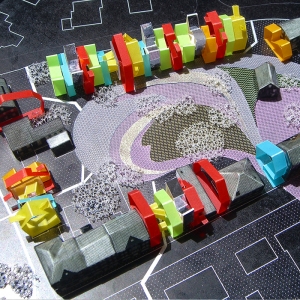 E9 Selb (DE) – Competition model
E9 Selb (DE) – Competition model
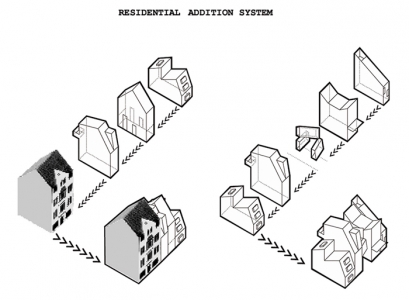 E9 Selb (DE) – Addition system of the stripes
E9 Selb (DE) – Addition system of the stripes
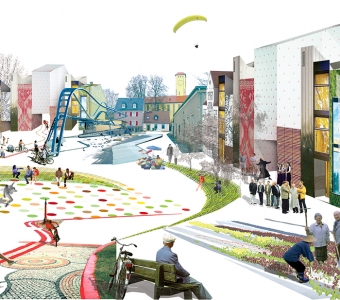 E9 Selb (DE) – Exterior view
E9 Selb (DE) – Exterior view
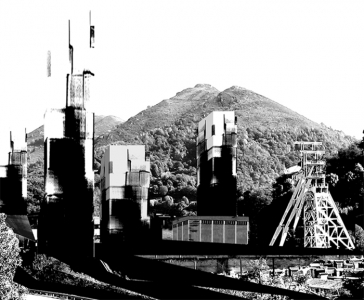 E9 Ama (ES) – Exterior view
E9 Ama (ES) – Exterior view
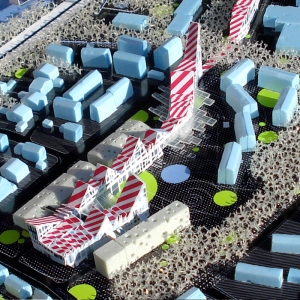 E10 Forchheim (DE) – Competition model
E10 Forchheim (DE) – Competition model
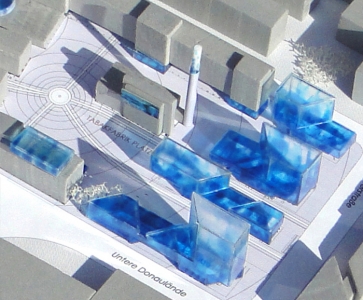 E11 Linz (AT) – Competition model
E11 Linz (AT) – Competition model
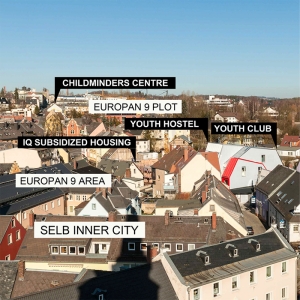 Selb (DE) – View of the Urban Regeneration
Selb (DE) – View of the Urban Regeneration 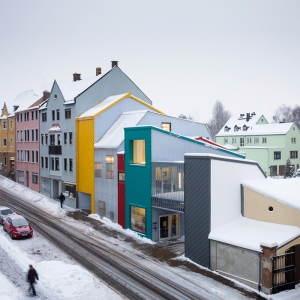 Selb (DE) – Childminders Centre,
Selb (DE) – Childminders Centre, 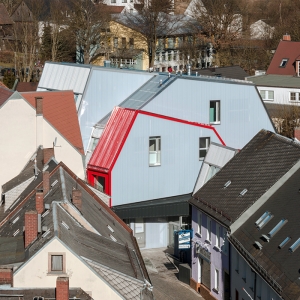 Selb (DE) – Youth Club & Hostel,
Selb (DE) – Youth Club & Hostel, 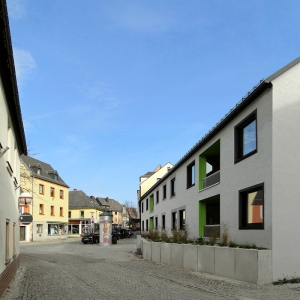 Selb (DE) – IQ Experimental Subsidized Housing,
Selb (DE) – IQ Experimental Subsidized Housing, 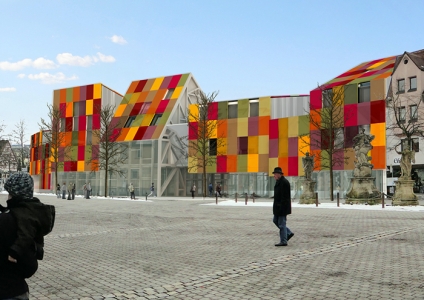 Forchheim (DE) – Mixed-use implementation
Forchheim (DE) – Mixed-use implementation 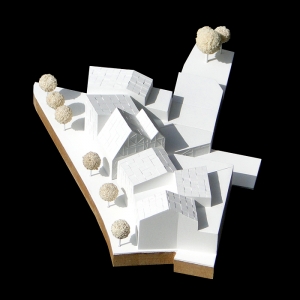 Forchheim (DE) – Mixed-use implementation
Forchheim (DE) – Mixed-use implementation 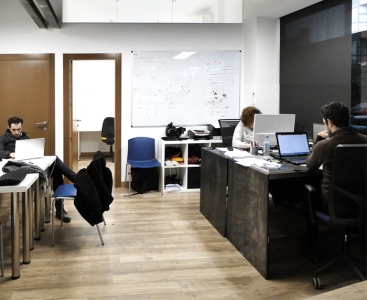 Gutiérrez-delaFuente Arquitectos office in Madrid
Gutiérrez-delaFuente Arquitectos office in Madrid
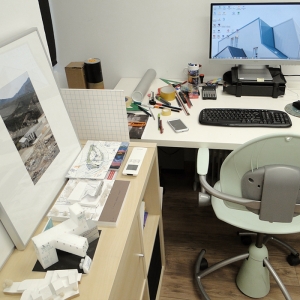 Models (2010)
Models (2010)
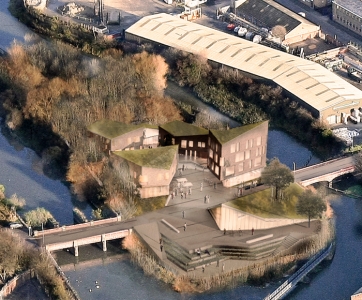 Regeneration of Soar Island, Leicester (UK) –
Regeneration of Soar Island, Leicester (UK) –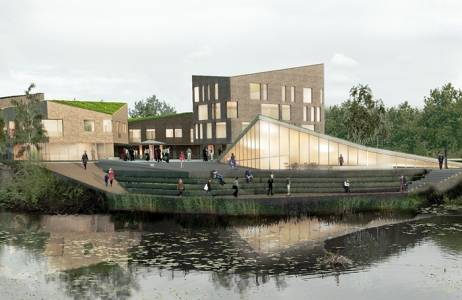 Regeneration of Soar Island, Leicester (UK) –
Regeneration of Soar Island, Leicester (UK) –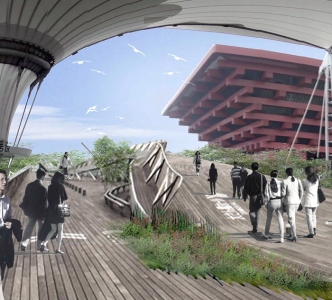 Transformation of the Expo 2010 Site, Shanghai
Transformation of the Expo 2010 Site, Shanghai 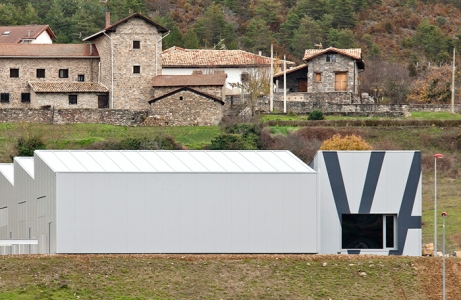 Multipurpose Centre, Navarra (ES) – 1st Prize
Multipurpose Centre, Navarra (ES) – 1st Prize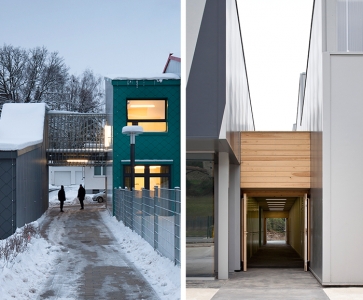 Childminders Centre, Selb (DE) + Multipurpose
Childminders Centre, Selb (DE) + Multipurpose 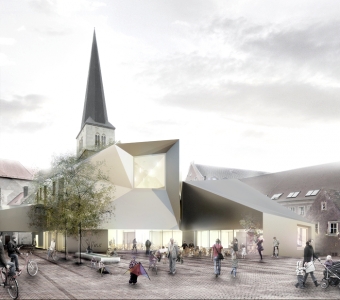 IGZ Centre and Intergenerational Quartier,
IGZ Centre and Intergenerational Quartier, 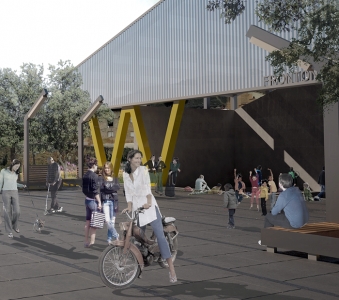 Morentin Square, Navarra (ES) – 1st Prize
Morentin Square, Navarra (ES) – 1st Prize  Sejong-daero Historic Cultural Space, Seoul
Sejong-daero Historic Cultural Space, Seoul  Sejong-daero Historic Cultural Space, Seoul
Sejong-daero Historic Cultural Space, Seoul